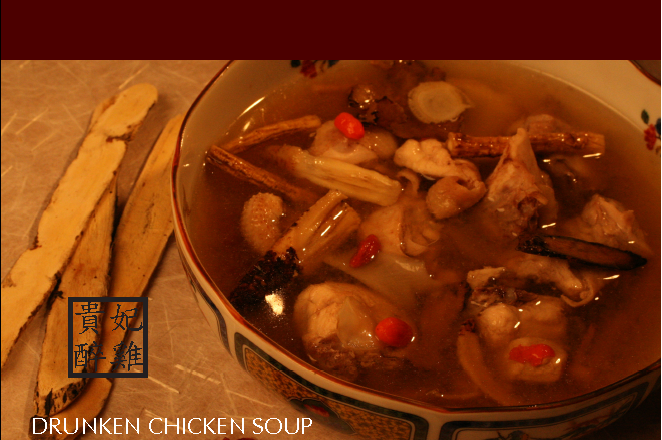| Recipe Corner Drunken Chicken Soup ???? 
INGREDIENTS:
- 1 whole chicken
- 1400 cc (1400 ml) rice wine
-
10 g (0.4 oz) cinnamon twigs
-
3 g (0.1 oz) tangkuei (??)
-
3 g (0.1 oz) cnidium (???)
-
3 g (0.1 oz) rehmannia (cooked) (??)
-
30 pieces (0.1 oz) jujube (red) (??)
-
10 g (0.4 oz) lycium (???)
-
5 g (0.2 oz) codonopsis (??)
-
10 g (0.4 oz) astragalus root (??)
-
3 g (0.1oz) licorice (??)
This recipe makes 5 ~ 7 servings PREPARATION:
-
Remove giblets from cav?ity of chicken. Wash the chicken thoroughly.
-
Chop into 3 inch pieces (bone in).
COOKING:
-
Place chicken pieces in a deep stainless steel pan (do not use Teflon-coated pans). Add the rice wine and all of the herbs. Cover with a lid.
-
Bring to a boil. Uncover the pan and ignite the alcohol vapor and wait for the fire to extinguish on its own.
-
Cook over medium flame for 30 minutes or until jujube softens.
-
Server hot
---------------------------------------------------------------------------- Additional Information for the above Chinese Herbs used in the Recipe: Tangkuei (Dang Gui or Tong-Kui) ?? The dried root of A. sinensis is commonly known as Chinese angelica (??; d?nggu?; tong-kui) and is widely used in Chinese traditional medicine for women's health, cardiovascular conditions, osteoarthritis, inflammation, headache, infections, mild anemia, fatigue and high blood pressure despite a lack of clinical data and trials showing effectiveness in humans. From the perspective of Traditional Chinese Medicine (TCM), dong quai is considered sweet, acrid, and warm in properties. And it covers three meridians, including liver, heart, and spleen. Its key functions are to enrich the blood and invigorate the circulation of blood, regulate the menstrual function to ease pain, and loose the bowel to relieve constipation. Cnidium (She Chuang Zi) ??? Cnidium is a plant that is native to China. It has also been found in the US in Oregon. The fruit, seed, and other plant parts are used as medicine. Cnidium has been used in Traditional Chinese Medicine (TCM) for thousands of years, often for skin conditions. It's not surprising that cnidium is a common ingredient in Chinese lotions, creams, and ointments. The medicinal part of cnidium monnieri, also known as She Chuang Zi in Chinese herbal medicine, is its fruits or seeds, which have long been considered an essential herb for skin diseases and pruritus. Rehmannia (cooked) Shu Di Huang ?? Cooked rehmannia root, also called Shu Di Huang in Pinyin, is produced throughout China. However, when it comes to medicinal uses, the herb from Huaiqing region in Henan province is thought to be the most "authentic" species. Thanks to its wide ranging medicinal properties, it has long been known as one of the 4 most famous Huai-medicines. Compared to raw or fresh rehmannia root, its tonic properties have been greatly enhanced by processing. Jujube (Da Zao) ?? Jujube fruit, also known as red date, Da Zao, and Chinese date, is native to China. Actually jujube tree has been cultivated there since 4,000 years ago. In ancient times, it was classified as "The Five Fruits" along with peach, plum, prunes mume, and apricot. The benefits of jujube are too numerous to ignore. Lycium (Gou Qi Zi) ??? Goji berries, also known as Gou Qi Zi, have been regarded as general nutritive tonic, noted anti-aging herb, and eyesight-improving medicine since long time ago. In order to keep in good health, promote good eyesight, and slow down aging, people keen on nourishing life consume it on daily basis by making tea, soaking in rice wine, stewing soup, cooking congee, and many other ways. That is why this herb is frequently found in many excellent cuisine and herbal recipes. Thanks to it is rich in a variety of nutrients such as carotene, vitamin A1, B1, B2, C, calcium, iron and other necessary nutrients, today this miracle fruit has been extensively applied for many purposes. Codonopsis (Dang Shen) ?? Codonopsis pilosula is no stranger to most Chinese since this herb is a common ingredient in the everyday recipes of soups and steamed dishes. In China it is better known as Dang Shen, a major tonic for nourishing the vitality. As you may know, ginseng is another key Qi tonic. Astragalus root (Huang Qi) ?? Astragalus root, also called Huang Qi (literally yellow senior) in Chinese name, is a common herb that is frequently used in traditional Chinese medicine. In addition to its extensive medicinal uses, this herb is also one important ingredient in many popular Cantonese soup recipes for the purpose of tonifying. As one of the 50 fundamental Chinese herbs that are frequently used in TCM, astragalus actually has been used as an essential tonic for more than 2,000 years. Licorice (Gan Cao) ?? In traditional Chinese medicine, liquorice (??), is believed to "harmonize" the ingredients in a formula and to carry the formula to the 12 "regular meridians". Licorice root, also known as Gan Cao and Radix Glycyrrhizae, is one of well-known herbs primarily used as a harmonizer in Chinese herbal formulas. By contract, western clinical medicine uses it more as a moderator thanks to its anti-inflammatory, antispasmodic and antacid effects. In fact, this herb has long been used as medicine in ancient China since 2,000 years ago, which was recorded in the oldest herbology classic of "Shen Nong's Herbal Classic" and listed as one of the superior drugs there. In addition, it was highly regarded as "the Teacher of Emperors" in the kingdom of herbs by Tao Hongjing, a famous physician in the Southern Dynasties (420-589).
|